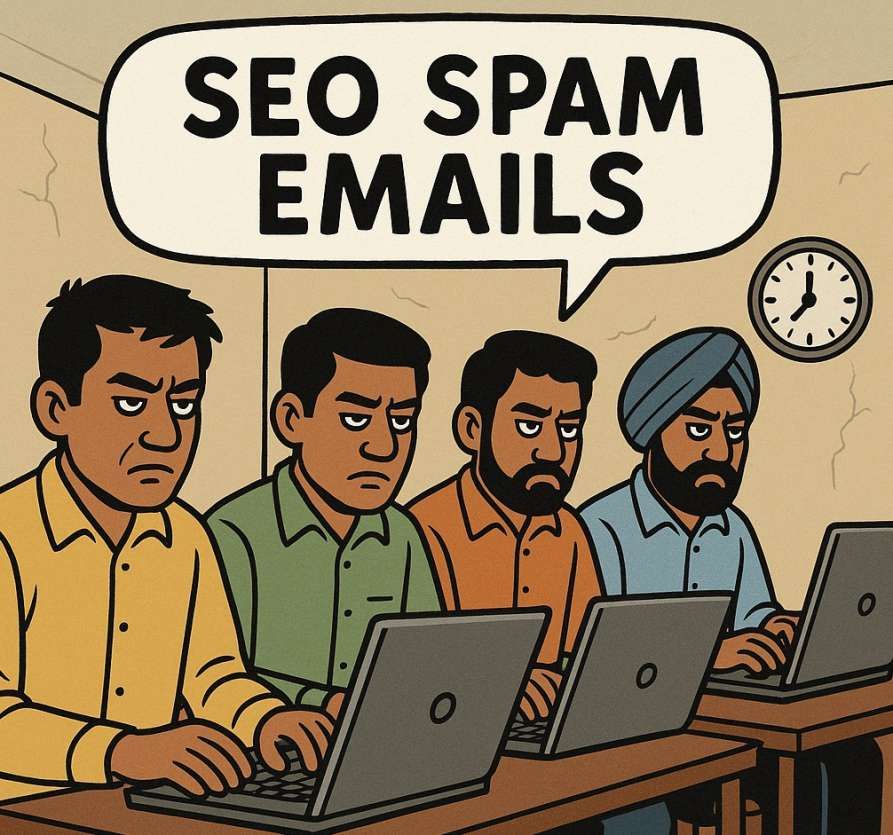\ It’s 2025, and somehow, despite Google's near-omniscient algorithms and AI prowess, my Gmail inbox still looks like a dumping ground for third-rate spam from so-called “SEO experts” and “web development companies,” mostly based in India.
\ The annoying and unsolicited emails flood inboxes every single day, each one a slight variation of the last: bad grammar, fake names like “Jennifer Smith” or “Alex Brown,” and generic, borderline deceptive promises like “guaranteed top ranking on Google in 10 days” or “expert WordPress redesigns for just $199.” It’s relentless, shameless, and absolutely maddening.
\ And here's the kicker: Gmail knows. Their AI can tell the difference between [spam]() and legitimate communication with terrifying precision when it wants to. Yet somehow, these spammy “Hi Sir/Madam” cold pitches from random Gmail addresses (often @gmail.com or .in domains) keep slipping through the filters and into our inboxes.
\ The messages follow a predictable format—mass-blasted, unsolicited, and often masked under the guise of “business opportunities.” Make no mistake: these are not just annoying; they are predatory marketing ploys designed to scam small business owners and freelancers who may not know better.
\ Let’s be brutally honest here: this is an industry, not just a few bad apples. There's an entire shadow economy of digital marketing mills, lead generation farms, and so-called SEO “agencies” that operate in high-volume, low-quality models.
\ They purchase email lists, scrape LinkedIn, or use shady data vendors to get leads, then spam indiscriminately. It’s digital pollution, and much of it is rooted in poorly regulated outsourcing hubs in India, where enforcement is practically nonexistent, and accountability is an afterthought.
\ You might say, "Just mark it as spam." I have. Hundreds of times. And Gmail's spam filter does catch a lot, but not enough. These operators have gotten smart—they rotate email accounts, subtly change their wording, and sometimes even attempt follow-ups.
\ They evade spam filters the same way malware evades antivirus software: constantly evolving. But here's where Google is complicit—because it allows it. Gmail still lets people send mass emails from personal Gmail accounts. There’s no throttle, no vetting, no authentication process when someone opens a Gmail account with the sole purpose of blasting thousands of junk SEO offers for distributed fake accounts
\ This isn't about targeting one country unfairly. This is about the disproportionate volume of spam originating from specific known sources—often clustered in cities like Noida, Delhi, or Ahmedabad.
\ It’s not xenophobic to call out a problem that’s geographically concentrated and structurally exploited. These entities hide behind VPNs, fake names, and burner accounts, and Google does nothing but twiddle its thumbs while real users waste hours deleting garbage and trying not to fall victim to scams.
\ Google has the data. They have the AI. They own the infrastructure. They could put a stop to this if they wanted to. They could implement aggressive outbound spam detection. They could rate-limit personal Gmail accounts that send too many cold emails.
\ They could apply stricter monitoring of new accounts exhibiting mass-mailing behavior. But they don’t. Why? Because spam like this doesn’t really hurt them. In fact, some of it drives people toward paid Google Workspace accounts or filters that promise better management features. Meanwhile, the rest of us are stuck hitting “report spam” like it's a full-time job.
\ At this point, it’s negligence. And worse, it erodes trust. Gmail used to be the gold standard of email services. But if it continues to allow its platform to be weaponized by shady overseas lead farms peddling fake SEO and half-baked web development, it’s going to lose that edge.
\ Because once spam becomes indistinguishable from legitimate email, your inbox becomes useless.
\ 
\
And It's Not Just Gmail — Outlook Is a Spam Sewer Too
As much as Gmail deserves the heat, let’s not pretend Outlook is innocent here. If Gmail is the front door spammers are walking through, Outlook is the back window they’re crawling into.
\ These same shady SEO and web development peddlers have taken to creating free Outlook, Hotmail, and Live.com addresses to bypass Gmail’s increasingly decent (though still flawed) spam detection. And what’s worse? Outlook’s spam filters are even less reliable.
\ It’s the same pattern: an email arrives from a sketchy-looking Outlook address like seoexpert2023@outlook.com or websolutionsindia@live.com, with a subject line like “Improve Your Google Ranking” or “Website Redesign Proposal.”
\ The body of the email is the same template garbage—broken English, absurd claims, and fake names—and somehow, it lands right in your inbox. Why? Because Microsoft’s Outlook spam filtering is stuck in 2010. It's slow to learn, easy to manipulate, and barely flags these templated garbage messages as suspicious.
\ And just like Gmail, Outlook allows these free accounts to be spun up in bulk with very little friction. No real identity verification, no email send limits that matter, no proactive enforcement. These platforms are being weaponized by spam factories, and the tech giants hosting them are still acting like spam is just a "cost of doing business" rather than a quality of service issue.
\ We’re not asking for miracles—we’re asking the two biggest email providers on the planet to stop being passive hosts to spam operations run from digital sweatshops. Gmail and Outlook both have the resources and the AI capability to end this flood of junk. The only thing missing is the will.
\ Google, Microsoft, it’s time. No more excuses. No more turning a blind eye. Start cracking down on this flood of SEO and web dev spam originating from Gmail accounts. Your users are tired of wading through it. The tools exist. You have the power. Do the right thing—for your platform, your users, and the integrity of online communication.
Tidak ada komentar:
Posting Komentar